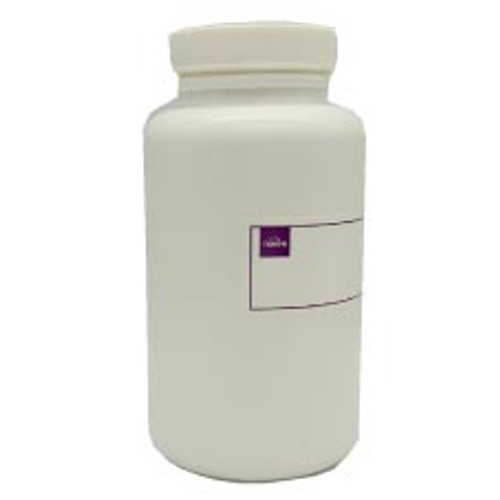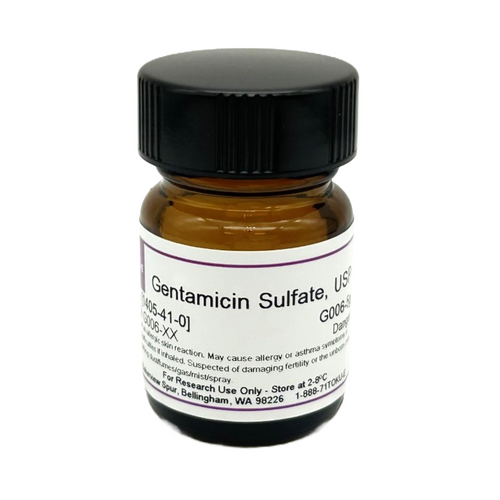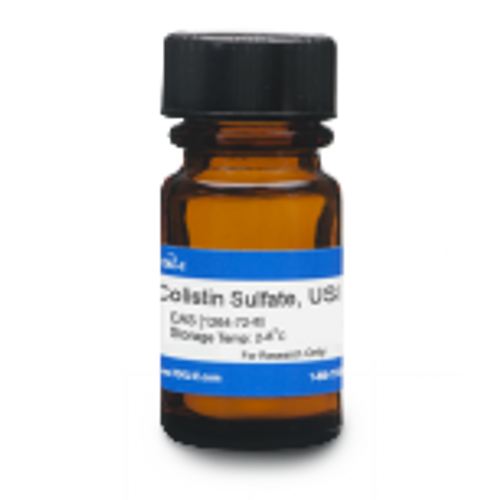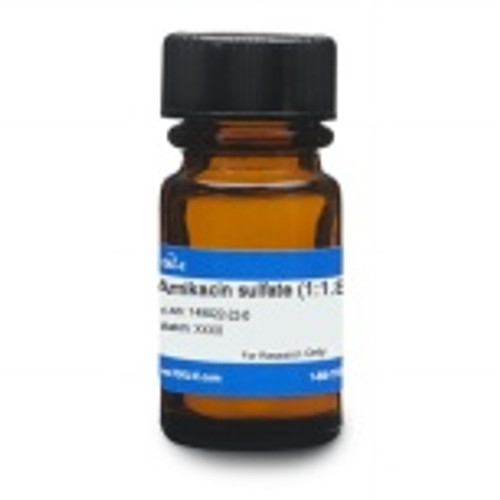Bleomycin Sulfate, USP is a chemotherapeutic agent and antibiotic commonly used in cancer research. Bleomycin is a mixture of glycopeptide antibiotics Bleomycin A2 and Bleomycin B2 in the ratio of 2:1 accordingly. The compound is isolated from Streptomyces verticillus.
Bleomycin Sulfate, USP is soluble in water.
We also offer:
- Bleomycin (B053)
- Bleomycin A2 Sulfate (B019)
- Bleomycin A5 Hydrochloride (B004)
- Demethylbleomycin A2 Sulfate, EvoPure® (D023)
| Mechanism of Action | The mechanism of action of Bleomycin Sulfate is not well defined; however, it is thought to chelate metallic ions which decreases enzyme activity and stability. This effect is believed to cause the enzymes to react with oxygen, producing free radicals which create single-stranded breaks in deoxyribose sugar. Bleomycin's anticancer activities include the increase of caspase-3 and p53, and the inhibition of telomerase activity leading to apoptosis. The anticancer properties derives from its ability to affect DNA cleavage in cancer cells. |
| Cancer Applications | Bleomycin contains a disaccharide moiety composed of 2 unusual sugars, L-gulose and 3-O-carbamoyl-D-mannose. Bleomycin could be regarded as a modular system composed of a tumor-targeting agent (the dissacharide moiety) and a tumoricidal agent (deglycobleomycin). The disaccharide moiety is responsible for the tumor cell targeting properties of Bleomycin. Bleomycin analogs were prepared, the glycosylated analogs were more cytotoxic to cultured DU145 prostate cancer cells. These findings establish a role for the Bleomycin disaccharide in tumor targeting/uptake and suggest that the disaccharide moiety may be capable of delivering other cytotoxins to cancer cells. Cytotoxicity testing with DU145 human prostate cancer cells in vitro (Schroeder et al, 2014).
Bleomycin is used in combination with other antineoplastic agents in studying lymphomas, testicular carcinomas, and squamous cell carcinomas. In this report, we found that the human L-carnitine transporter (hCT2) is involved in Bleomycin-A5 uptake. NT2/D1 human testicular cancer cells which highly express hCT2 are very sensitive to Bleomycin-A5. Data suggest that hCT2 can mediate the uptake of Bleomycin A5 (Aouida M et al, 2010). A well-known characteristic of tumor cells is the Warburg effect, that is the propensity of tumor cells to produce increased ATP via glycolysis rather than by mitochondrial oxidative phosphorylation. The shift to glycolysis is accompanied by upregulation of glucose transporters to provide the greater amounts of glucose needed to support increased glycolysis. If authors treated two normal cell lines (normal WI-38 cells and normal kidney CCD-1105 KIDTr cells) with the inhibitor rotenone (a mitochondrial complex 1 inhibitor), this forced these cells to use increase glycolysis in the same fashion as tumor cells and this resulted in an enhanced ability to incorporate BLM-Cy5. The finding implies that the Bleomycin saccharide moiety may be able to deliver other cytotoxins selectively to tumor cells (Mobasheril, 2005). |
| References |
Aouida M, Poulin P and Ramotar (2010) The human carnitine transporter SLC22A16 mediates high affinity uptake of the anticancer polyamine analogue Bleomycin-A5. J. Biol. Chem. 285:6275-6284 Aszalos A, Crawford J, Vollmer P, Kantor N and Alexander T (1981) High-performance liquid chromatographic determination of components of Bleomycin preparations. J. Pharm. Sci 70(8):878-880 PMID 6171636 Dorr, RT (1991) Bleomycin Pharmacology: Mechanism of action and resistance, and clinical pharmacokinetics. Semin. Oncol. 19(2): 3-8 PMID 1384141 Schroeder BR et al (2014) The disaccharide moiety of Bleomycin facilitates uptake by cancer cells. J. Am. Chem Soc. 136(39):13641-13656 Takita T et al (1972) Chemistry of bleomycin. IX. The structures of Bleomycin and phleomycin. J. Antibiot. (Tokyo) 25:755-757 PMID 4119701 |












